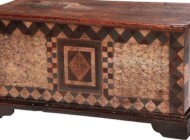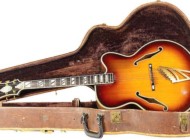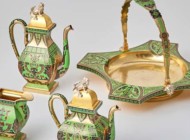By Greg Smith
UNITED STATES – In a way, auction houses, like every other retailer that developed an online selling conduit, were somewhat prepared for the day when face-to-face selling would decrease, though they certainly did not expect it to happen because of a pandemic. Instead they were just falling in line with the way business evolved and answering a client’s need as a growing demographic preferred to spend their weekends bidding from the couch instead of the sale room. Online bidding helped increase sales.
It is the only way to conduct auctions right now.
In the face of the COVID-19 virus, some auction houses are actively developing an online-only sale schedule while others are simply converting their scheduled live gallery sales to online-only formats.
With certain state governments barring any gatherings over ten people, previewing in person is not an option during the crisis. Antiques and The Arts Weekly spoke with a number of specialists and auctioneers to find out what takes its place.
Skinner Inc’s scheduled April 4 sale of American Furniture and Decorative Arts in Marlborough, Mass., has been converted into an online-only timed sale, open for bidding through April 13. That 273-lot sale is not an economy class ticket – as online-only sales have come to be known as a clearing house format for lower value items – instead it is a bonafide auction that offers at its top end a James Edward Buttersworth ship portrait with a $60/80,000 estimate.
“While Skinner is not open for preview, we are definitely open for business,” said Chris Barber, deputy director of American furniture and decorative arts at Skinner. “We have always prided ourselves on our ability to provide good and sound client-specific advice to our clients. We generally know their interests and desires and whether they need things. Right now, we’re putting that to the test more than we ever have.”
Barber says that Skinner is on hand to provide the senses that clients lose through digital screens.
“Using the old adage ‘a picture is worth 1,000 words,’ now ten pictures are worth 10,000 words and 20 are worth 20,000 words. We have a telephone in our pocket that works as a capable camera, so the ability to take pictures and send them instantly has revolutionized how quickly we can share information on objects with people… It’s amazing how quickly the world at large has adapted to a reasonable facsimile instead of a face to face meeting.”
Barber and other specialists are in the gallery to answer any and all questions from previewers, and they have been pouring in.
“We’ve always had a rule of thumb: if we have a sale that has 500 lots and we field 50 to 70 percent of that number in inquiries, that’s usually a very busy run up to a sale. In this particular sale, we have 273 lots and it doesn’t close for another 11 days – we are already at 320 total inquiries for that sale. That’s already over 100 percent of the lots in the auction, so we’re probably already running double what we would consider a large number of inquiries.
“People are understanding of the situation and also confident in their ability to bid effectively. It’s been really encouraging that our clients, who have historically been detail-oriented and in need of good information, have had information provided to them by Skinner specialists and have seemed to not slow down in their approach to bidding. I think it means we’re seeing proof that people have confidence in our specialists to provide information that they need to feel comfortable.”
No question is a bad one for potential bidders, and the specialists are understanding of all concerns.
“When you buy a dining room table from Crate and Barrel, you pretty much know what you’re going to get delivered. But buying a dining room table at auction, you want to know if your knees are going to fit under it, if the swing leg will work, and we’re happy to overcommunicate things and answer all of the questions,” Barber said.
Even though New York City-based Doyle has closed down its building on 87th Street, the firm has produced a solid lineup of online-only sales with soft closes throughout the month of April. Among them is a Jewelry auction, closing April 14; a Fine Literature sale, closing April 15; and American Paintings, Furniture & Decorative Arts, which closes April 21.
“There has been incredibly quick digital adaptation,” said chief executive officer Laura Doyle. “People that were resistant to bid online in the past, or always insisted on a printed catalog, have quickly adjusted to the new normal. And as much as we are using and relying on and adapting to these new technologies, the people element is still most important. Ultimately, we’re not necessarily seeking out brand new groups of buyers, it’s about accommodating and meeting the needs of existing clients. The reason why we can operate in this environment successfully is because we’ve built such great trust in terms of our team and our expertise for our bidders to feel comfortable buying from us and calling our specialists and trusting their sight. So as much as it’s digital, it’s still human.”
Doyle notes that interest in content has skyrocketed amid the crisis.
“People are craving contact. The readership on our e-newsletter “Notebook” has gone up dramatically. People are devouring the content. We have a captive audience, one that is looking for normalcy in this environment, and they’re okay with a new normal. They still want to buy things of value and beauty, they’re spending a lot of time in the home and thinking about what they need and want as they look at their collection. There is also this element of slowing down that lends itself to timed auctions, but then there’s still that live bidding adrenaline kick at the end. They still have all that time to ask questions and look and interface. I think the auction market is poised well for this environment.
“As we’re all stuck inside, it’s such a great moment for connoisseurship,” Doyle said. “To look into things that people have or things they are interested in. Hopefully it’s all of our moment to reinvent this business and this market and bring it into the next century.”
In Asheville, N.C., Andrew Brunk of Brunk Auctions is in the middle of his postsale routine following an auction last weekend that grossed $1.4 million.
“Buying antiques has historically been about seeing things yourself, seeing what resonates with you and looking hard at condition,” Brunk said. “But that’s been changing over the last decade with online bidding, with people buying major works of art online. Everyone in the industry has been adjusting to that and the current online-only boom is an extension of that – to do things virtually no matter what.”
Brunk says that his firm is diligent and careful in their condition reports, which he notes have always been a point of pride for his auction house.
“For many people, there’s no substitute for seeing things in person, but we had a lot of people respond to opportunities to Facetime preview. I did a good bit of it and other specialists did, too. In some cases, it was people who probably wouldn’t have made the trip to our gallery anyway, but because of everything that was going on, it promoted that possibility to see our preview. I spent at least an hour on one clock with one bidder. There are objects in certain categories that are tricky to vet, but with a good light and patience and deconstructing things when possible, we had a lot of success with it.”
Brunk said that his exposure to clients is largely unchanged.
“In some cases, people wanted to Facetime that probably didn’t need to, but it provided that little bump to get their enthusiasm and confidence up. It was the next best thing. In other cases, we Facetimed in the black light booth, where they could say, ‘turn it this way, what about this part, what are you seeing there?’ It’s labor intensive, but no more than if that person had flown into the gallery, I probably would have spent that same time with them. If someone had a list, we would go over those things, but then we would take a walking tour of the gallery and they would ask us to show them other things that they weren’t tuned into.
“It’s imperfect,” Brunk said, “but it did prove to be effective. It’s not infallible, but just like seeing it with your own eyes isn’t always infallible. Being able to answer questions was an important part of what turned out to be a very successful sale for us.”
Speaking with two estate auctions, Hartzell’s and S&S, who both held sales over the weekend of March 28 and whose post-sale reports appear in this issue, the auctioneers related they had similar experiences with previewers.
John Hartzell of Hartzell’s Auction Gallery in Bangor, Penn., said, “We had a lot more phone calls from previewers, because what you didn’t have is the people coming in for the three-day preview. We usually have 250 people come through the building in foot traffic. None of these people got to pick the lot up or handle it, so they relied more on descriptions and condition reports, and us giving them over the phone advice. I Facetimed with several people so they could better look at a piece.”
John Amaradio of S&S Auctions in Repaupo, N.J., said, “We had almost nobody come to view the things, so that was easy…Instead they called and emailed with questions. It’s an adjustment, we’ve been in business since 1972, and we’ve really reinvented ourselves in the last 38 years, but now we’re really reinventing ourselves, we’re going to have to become a completely online business for the next few months.”
A large element of the auction buying process is opportunity – when a lot crosses the block, it is a flashing moment when that thing is only available for sale for less than a minute, or less than 15 seconds in some cases. It creates a mentality in buyers where they, too, begin to think in terms of opportunity, and if buyers were ever looking for one, they are staring directly at it in the current moment.
Buying at auction in the coronavirus age requires trust and communication – verbal or visual – and auction specialists are finding that business can continue as their existing buyers are content to rely on them.




